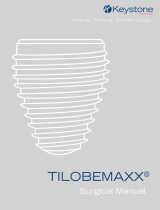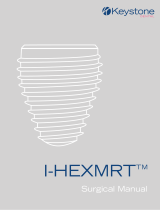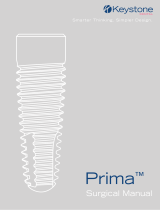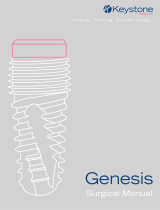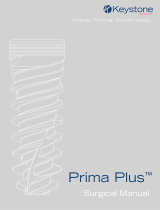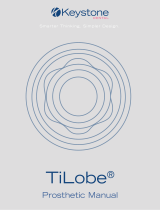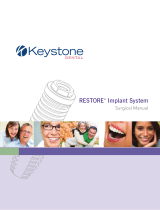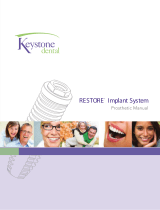Page is loading ...

TILOBEMAXX® SURGICAL MANUAL

2

3
TABLE OF CONTENTS
TILOBEMAXX® IMPLANT SURGICAL MANUAL
SURGERY
TILOBEMAXX® Characteristics 4
Surgical Considerations 5
TILOBEMAXX® Surgical Sequence 7
Drilling Sequence 10
Product specifications are subject to change without notice.
Items illustrated are not to scale.

4
Design Features
The TILOBEMAXX® Implant features an internal 6-lobed connection
and a body with a larger-than-conventional diameter to fill a
molar site, ultimately achieving primary stability by engaging the
perimeter of the bony wall. The TILOBEMAXX® Implant has a tapered
body, an enhanced surface and is designed to fit the natural shape
of a molar socket. The TILOBEMAXX® Implant provides an optimal
fit in the multi-rooted immediate extraction site, minimizing bone
loss and reducing treatment time. The wider implant body requires
larger-than-conventional drills which generate higher torque values
than regular size implants.
3.5
3.8
3.5
3.8
3.5
3.8
TILOBEMAXX®
CHARACTERISTICS
5.5 mm
11.0 mm
7.0 mm
7.5 mm
11.0 mm
9.0 mm
6.5 mm
11.0 mm
8.0 mm
Dimensions
The TILOBEMAXX® Ø7.0 mm is available in
7, 9 and 11 mm lengths and features a Ø5.5
mm platform. Abutments are available in
flares of 6.0 and 7.0 mm.
The TILOBEMAXX® Ø8.0 mm is available
in 7, 9 and 11 mm lengths and features a
Ø6.5 mm platform. Abutments are available
in aflares of 8.0 and 9.0 mm.
The TILOBEMAXX® Ø9.0 mm is available
in 7, 9 and 11 mm lengths and features a
Ø7.5 mm platform. Abutments are available
in flares of 8.0 and 9.0 mm.

5
Considerations
INDICATIONS
TILOBEMAXX® Implants are intended to be implanted into the maxillary
and mandibular molar region where adequate bone is available. The
TILOBEMAXX® Implants provide support for fixed or removable dental
prostheses in a single tooth, partially edentulous prosthesis, or full
arch prosthesis. The TILOBEMAXX® Implants further add the option for
immediate temporization on single and splinted multiple unit restorations
when excellent primary stability is achieved and with appropriate occlusal
loading, to restore masticatory function.
CONTRAINDICATIONS
Implant placement is contraindicated in patients with inadequate quality
and/or quantity of bone, as well as patients with medical disorders unfit
for general oral surgery procedures, e.g., blood dyscrasias, and bone
dyscrasias. Additional contraindications include, but are not limited to,
individuals with localized or systemic factors that could interfere with the
healing process, e.g., infections, steroid therapy, smoking, and bruxism.
NOTE: Improper treatment planning and/or implant placement might
result in implant failure and potential loss of the surrounding bone.
HEALING PERIOD
Any inadvertent loading of the implant should be avoided, especially during
the first 6 weeks of healing to achieve optimal osseointegration.
IMMEDIATE RESTORATION
TILOBEMAXX® Implants may be immediately temporized on single and
splinted multiple unit restorations when excellent primary stability is
achieved and with appropriate occlusal loading. Whenever possible these
restorations should be out of occlusion in both centric and eccentric
positions. The patient should adhere to a soft diet and place minimal
forces on these restorations for 6 to 8 weeks.
DELAYED RESTORATION
The healing period is generally 3-4 months in the mandible and 4-6 months
in the maxilla, however, healing periods for each patient vary.
After the appropriate healing period the Cover Screw is removed, the
Healing Abutment is placed and the gingiva is slightly sutured around.
In some cases sutures might not be necessary. The Healing Abutment
remains in place for approximately 2 weeks. Impressions can then be taken
and the prosthetic protocol may proceed.
For additional information, please consult the
Keystone Dental TiLobe® Prosthetic
Manual
.
SURGICAL
CONSIDERATIONS
Implant Selection and Placement
Implant selection should be made with the final restorative result as the
primary consideration. The final implant position is at the discretion of
the surgeon. Each case should be evaluated on the basis of placement,
protocol and type of implant prior to osteotomy preparation.

6
PRE-CLEANING
• Used instruments should be soaked immediately in instrument
cleaning solution to avoid the drying of blood, saliva and tissue
residue.
• Used surgical trays including grommets must be cleaned with a
suitable disinfectant.
• Multiple-part instruments must be disassembled prior to
cleaning and sterilization.
• Internal debris/residue of instruments must be removed with a
soft brush.
• Instruments should be inspected, cleaned separately and
discarded if damaged.
PRINCIPAL CLEANING
• Best results are achieved if surgical instruments are cleaned by
material type.
Instrument Care
Instruments and Surgical Trays must be cleaned and sterilized prior to first
and after each use based on established procedures. Proper instrument care
is an important part of successful implant dentistry.
SURGICAL
CONSIDERATIONS
• Instruments and trays can be cleaned and disinfected in a
dedicated dishwasher or alternatively by hand, followed by
an ultrasonic bath with a detergent appropriate for surgical
instruments.
• Instruments and trays must be rinsed and dried thoroughly.
PACKAGING
• Instruments are placed in the tray and then wrapped in
sterilization paper or a sterilization pack featuring indicating
tape and sterilization date.
STERILIZATION
Instruments and tray should be autoclaved at up to 134˚C (~273°F) with a
sufficient drying cycle to avoid instrument corrosion. Instruments should be
placed in the tray and wrapped in sterilization paper or sterilization packs
featuring indicating tape and date of sterilization.
SURGICAL MOTOR AND HANDPIECE
Cleaning and maintenance instructions for W&H handpieces and motors
can be found on www.wh.com.

7
Step 5
The osteotomy site is further widened
utilizing a Ø3.5 mm x 8 mm Tapered Drill
(15840K) to the full depth of the drill at
approximately 500-800 rpm.
Step 6
The osteotomy site is further widened
utilizing a Ø4.3 mm x 8 mm Tapered Drill
(15841K) to the full depth of the drill at
approximately 500-800 rpm.
NOTE: Care must be taken to maintain the
integrity of the buccal plate while
widening the osteotomy. It is important to
maintain a 2 mm clearance between the
TILOBEMAXX® implant and the buccal
plate.
Step 7
The osteotomy site is further widened
utilizing a Ø5.0 mm x 8 mm Tapered Drill
(15842K) to the full depth of the drill at
approximately 500-800 rpm.
Step 8
The osteotomy site is further widened
utilizing a Ø6.0 mm x 8 mm Tapered Drill
(15843K) at approximately 500-800 rpm.
Step 1
The tooth is removed atraumatically
ensuring the structural integrity of the
extraction socket. The buccal plate and
the sinus (maxilla) must be intact and
no major grafting should be required. It is
recommended that the TILOBEMAXX® be
seated 2.0 mm sub-crestal, relative to the
lowest part of the crest.
Step 2 (Optional)
Utilizing a Round Bur (15828K), the osteotomy
is initiated by drilling in the center of the
remaining intra-radicular bone.
Step 3
Utilizing the Ø2.0 mm Spade Drill (G21243),
the osteotomy is initiated by drilling through
the remaining intra-radicular bone.
NOTE: In bone types I/II it is recommended
to progressively widen the osteotomy with an
intermediate Ø2.0 mm drill (15829K).
I-HD
I-SCS
I-HD
I-SCS
I-HD
I-SCS
I-HD
I-SCS
I-HD
I-SCS
Surgical Sequence - TILOBEMAXX® Ø8.0 mm x 11 mm
(For demonstration purposes)
TILOBEMAXX®
SURGICAL SEQUENCE
I-HD
I-SCS
I-HD
I-SCS
I-HD
I-SCS
Step 4
The osteotomy is widened with a Ø3.0 mm
Twist Drill (15830K) to the required depth at
1000-2000 rpm.
Surgical Pointers for bone type I/II:
• Properly align the latch-type instrument
within the drill extension and/or handpiece
• Only use drill extension when absolutely
necessary
• Rotate the latch-type instrument when
engaging into W&H handpiece to ensure
proper seating

8
Step 9
The osteotomy site is further widened
utilizing a Ø7.0 mm x 11 mm Tapered Drill
(15833K) at approximately 300-500 rpm.
Step 10
The final Ø8.0 mm x 11 mm Tapered Drill
(15836K), which is slightly smaller than
the implant selected, is then inserted to the
required depth at approximately 300-500
rpm to provide the final osteotomy shape.
NOTE: It is recommended that the
TILOBEMAXX® be seated 2 mm sub-crestal,
relative to the lowest part of the crest.
Step 11
It is recommended to use a Profile Gauge
(15858K) to determine the proper site
preparation prior to implant placement.
Step 12
A dedicated Bone Tap (15849K) can be
used in addition to the Tapered Drill, or as
a replacement to finalize the osteotomy
(depending on bone quality). The Bone Tap
is inserted at 15-20 rpm.
NOTE: The Bone Tap can be utilized with
the Surgical Ratchet (L1702-01K) to tap
the bone by using the Ratchet Adapter
(15883K).
TILOBEMAXX®
SURGICAL SEQUENCE
I-HD
I-SCS
I-HD
I-SCS
Step 13
The TILOBEMAXX® Implant is carefully
removed from its sterile vial utilizing the
Implant Driver (15720K or 15721K) pre-
attached to the handpiece and is carried to
the osteotomy site.
NOTE: Each indentation on the direct-to-
implant driver aligns with an internal lobe
of the implant. It is recommended to place a
lobe buccally to ensure ease of restoration.
Step 14
Insert the implant into the osteotomy at
15-20 rpm and approximately 45 Ncm
(depending on bone quality). The Implant
Driver (15720K or 15721K) is disengaged
from the handpiece and remains
joined to the implant.
Step 15
Once the implant is placed, the
Surgical Ratchet (L1702-01K) is used
to fully seat the implant. The
Ratchet Adapter (15224K) is inserted
into the Surgical Ratchet to engage the
Implant Driver.
Once the implant is fully seated, the Surgical
Ratchet/Ratchet Adapter/Implant Driver
assembly is removed from the implant.
NOTE: Care must be taken that one lobe
faces buccally to ensure proper restoration.
I-HD
I-SCS
I-HD
I-SCS
I-HD
I-SCS
D-TAP-MAX9-7/9/11 D-TAP-MAX8-7/9/11
Dedicated
Bone Tap
I-HD
I-SCS

9
TILOBEMAXX®
SURGICAL SEQUENCE
Step 16
The Cover Screw or Healing Abutment is
placed with the Quad Driver (15272K).
NOTE: Healing Abutments are packaged
separately.
Step 17
The flap margins are positioned around
the Healing Abutment and sutured
in a tension-free manner. In some cases
sutures might not be necessary.
NOTE: It is recommended to take an
x-ray to ensure correct seating of
the Healing Abutment.
I-HD
I-SCS
I-HD
I-SCS
Prosthetic Reminder
TILOBEMAXX® Ø7.0 mm Implants feature a Ø5.5 mm prosthetic platform. Abutments are available in a flare of 6.0 and 7.0 mm.
TILOBEMAXX® Ø8.0 mm Implants feature a Ø6.5 mm prosthetic platform. Abutments are available in a flare of 8.0 and 9.0 mm.
TILOBEMAXX® Ø9.0 mm Implants feature a Ø7.5 mm prosthetic platform. Abutments are available in a flare of 8.0 and 9.0 mm.

10
Implant
Length Ø7.0 Drilling Sequence
7 mm Spade Drill 3.0 mm
Twist Drill
3.5 x 8 mm
Tapered Drill
4.3 x 8 mm
Tapered Drill
5.0 x 8 mm
Tapered Drill
6.0 x 8 mm
Tapered Drill
7.0 x 7 mm
Tapered Drill
7.0 x 7 mm
Profile Gauge
7.0 x 7 mm
Bone Tap
9 mm Spade Drill 3.0 mm
Twist Drill
3.5 x 8 mm
Tapered Drill
4.3 x 8 mm
Tapered Drill
5.0 x 8 mm
Tapered Drill
6.0 x 8 mm
Tapered Drill
7.0 x 9 mm
Tapered Drill
7.0 x 9 mm
Profile Gauge
7.0 x 9 mm
Bone Tap
11 mm Spade Drill 3.0 mm
Twist Drill
3.5 x 8 mm
Tapered Drill
4.3 x 8 mm
Tapered Drill
5.0 x 8 mm
Tapered Drill
6.0 x 8 mm
Tapered Drill
7.0 x 11 mm
Tapered Drill
7.0 x 11 mm
Profile Gauge
7.0 x 11 mm
Bone Tap
Implant
Length Ø9.0 Drilling Sequence
7 mm Spade Drill 3.0 mm
Twist Drill
3.5 x 8 mm
Tapered Drill
4.3 x 8 mm
Tapered Drill
5.0 x 8 mm
Tapered Drill
6.0 x 8 mm
Tapered Drill
7.0 x 7 mm
Tapered Drill
8.0 x 7 mm
Tapered Drill
9.0 x 7 mm
Tapered Drill
9 mm Spade Drill 3.0 mm
Twist Drill
3.5 x 8 mm
Tapered Drill
4.3 x 8 mm
Tapered Drill
5.0 x 8 mm
Tapered Drill
6.0 x 8 mm
Tapered Drill
7.0 x 9 mm
Tapered Drill
8.0 x 9 mm
Tapered Drill
9.0 x 9 mm
Tapered Drill
11 mm Spade Drill 3.0 mm
Twist Drill
3.5 x 8 mm
Tapered Drill
4.3 x 8 mm
Tapered Drill
5.0 x 8 mm
Tapered Drill
6.0 x 8 mm
Tapered Drill
7.0 x 11 mm
Tapered Drill
8.0 x 11 mm
Tapered Drill
9.0 x 11 mm
Tapered Drill
DRILLING SEQUENCE
Implant
Length Ø8.0 Drilling Sequence
7 mm Spade Drill 3.0 mm
Twist Drill
3.5 x 8 mm
Tapered Drill
4.3 x 8 mm
Tapered Drill
5.0 x 8 mm
Tapered Drill
6.0 x 8 mm
Tapered Drill
7.0 x 7 mm
Tapered Drill
8.0 x 7 mm
Tapered Drill
9 mm Spade Drill 3.0 mm
Twist Drill
3.5 x 8 mm
Tapered Drill
4.3 x 8 mm
Tapered Drill
5.0 x 8 mm
Tapered Drill
6.0 x 8 mm
Tapered Drill
7.0 x 9 mm
Tapered Drill
8.0 x 9 mm
Tapered Drill
11 mm Spade Drill 3.0 mm
Twist Drill
3.5 x 8 mm
Tapered Drill
4.3 x 8 mm
Tapered Drill
5.0 x 8 mm
Tapered Drill
6.0 x 8 mm
Tapered Drill
7.0 x 11 mm
Tapered Drill
8.0 x 11 mm
Tapered Drill
8.0 x 7 mm
Profile Gauge
8.0 x 7 mm
Bone Tap
8.0 x 9 mm
Profile Gauge
8.0 x 9 mm
Bone Tap
8.0 x 11 mm
Profile Gauge
8.0 x 11 mm
Bone Tap
9.0 x 7 mm
Profile Gauge
9.0 x 7 mm
Bone Tap
9.0 x 9 mm
Profile Gauge
9.0 x 9 mm
Bone Tap
9.0 x 11 mm
Profile Gauge
9.0 x 11 mm
Bone Tap

11
Notes:
Implant
Length Ø8.0 Drilling Sequence
7 mm Spade Drill 3.0 mm
Twist Drill
3.5 x 8 mm
Tapered Drill
4.3 x 8 mm
Tapered Drill
5.0 x 8 mm
Tapered Drill
6.0 x 8 mm
Tapered Drill
7.0 x 7 mm
Tapered Drill
8.0 x 7 mm
Tapered Drill
9 mm Spade Drill 3.0 mm
Twist Drill
3.5 x 8 mm
Tapered Drill
4.3 x 8 mm
Tapered Drill
5.0 x 8 mm
Tapered Drill
6.0 x 8 mm
Tapered Drill
7.0 x 9 mm
Tapered Drill
8.0 x 9 mm
Tapered Drill
11 mm Spade Drill 3.0 mm
Twist Drill
3.5 x 8 mm
Tapered Drill
4.3 x 8 mm
Tapered Drill
5.0 x 8 mm
Tapered Drill
6.0 x 8 mm
Tapered Drill
7.0 x 11 mm
Tapered Drill
8.0 x 11 mm
Tapered Drill

Headquarters
Keystone Dental Group
154 Middlesex Turnpike
Burlington, MA 01803 USA
Tel: +1 781-328-3490
Toll-free: 866-902-9272
www.KeystoneDental.com
©2021 KEYSTONE DENTAL, INC. 100034-EN01 REV F - 06/2021
/
